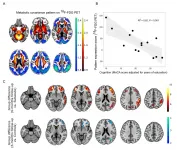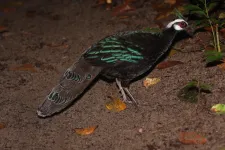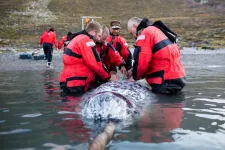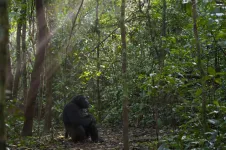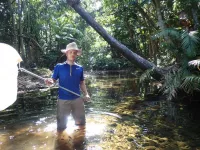(Press-News.org) Researchers from the Singapore University of Technology and Design (SUTD) have demonstrated a technology that rapidly detects pollutants in water by measuring their impacts on swimming microorganisms.
Their proof-of-concept, published in Scientific Reports, does not require any chemicals, reagents or laboratory equipment. Instead, it leverages the regular camera of a smartphone as well as microorganisms called Paramecia that are ubiquitous in water bodies--making it especially suitable for assessing water drinkability in underdeveloped regions.
Typically, levels of environmental pollutants are measured by assessing their impact on a given population. Though such impacts may be visible after several days for microorganisms, it takes several years for the true scale to be revealed in larger animals.
To accelerate these measurements, researchers led by Assistant Professor Javier Fernandez at the Fermart Lab used a simple computer vision method to track and measure the impact of pollutants on the behavior of microorganisms. Specifically, they used the changes in the swimming speed of Paramecium aurelia--a single-celled organism can move at surprising speeds of more than ten times their body length per second.
"We chose Paramecia because they are ubiquitous in water bodies and large enough to be seen with a normal camera," explained Fernandez. "They are also fast swimmers, so small differences in their swimming speed will translate to large changes, making them easy to measure."
By tracking the swimming speeds and movements of waterborne Paramecia through a simple microscope set up on camera phones, they found that they could accurately infer the quality of and presence of pollutants in water samples within minutes.
To track the Paramecia, the team recorded videos, then ran an object identification and tracking algorithm that would detect the creatures automatically and calculate their swimming speeds and movement. "Swimming speeds are slightly different between different individuals. But with all this data, we are able to reduce the impact of that variability and obtain general features of their swimming," said Fernandez.
Through their efforts, the researchers showed that the swimming speeds of Paramecia are affected by pollutants like the heavy metals zinc chloride and copper sulfate, as well as the common antibiotic erythromycin. These changes occurred within the range of the pollutants' permissible limits; for instance, at heavy metal concentrations half of those considered unsafe for drinking water, the average swimming speed of Paramecia was nearly halved.
Likewise, there were immediate and significant reductions to the swimming speed of Paramecia at concentrations considered hazardous--potentially allowing researchers to quickly evaluate a specific pollutant's impact in a specific environment.
"Taking a sample of water and measuring the speed of Paramecia can therefore be used as a straightforward method to assess the drinkability of water without the need for specialised equipment or chemicals," said Fernandez. "Usually, you would need a different test for each pollutant, but Paramecia swimming is a global measurement."
The team designed the system under the umbrella of what is known as "frugal engineering," where advanced methods like object tracking and analysis perform tasks with minimal frills, enabling widespread applicability with little resources.
According to the authors, the demonstrated correlation between the swimming speed of microorganisms and pollutant presence, and its assessment in just a few minutes, can be used as a straightforward, resourceless way to assess water quality globally or as a substitute for standardised methods to measure toxicity in laboratory environments.
"In the future, someone might try a different type of microorganism. Various pollutants would affect organisms differently, so pulling data together from multiple microorganisms would enable us to better understand the source of the pollutants," concluded Fernandez. "What we've demonstrated proves that we can get information on water quality in a cheap and simple way, without any technical instruments and in no time at all."
INFORMATION:
People with a rare autoimmune disease, who likely experience more serious isolation during a global pandemic, saw their anxiety and depression improve after receiving online mental health intervention through an international study involving investigators from Michigan Medicine.
The paper, END ...
Reston, VA--The effects of COVID-19 on the brain can be accurately measured with positron emission tomography (PET), according to research presented at the Society of Nuclear Medicine and Molecular Imaging (SNMMI) 2021 Annual Meeting. In the study, newly diagnosed COVID-19 patients, who required inpatient treatment and underwent PET brain scans, were found to have deficits in neuronal function and accompanying cognitive impairment, and in some, this impairment continued six months after their diagnosis. The detailed depiction of areas of cognitive impairment, neurological symptoms and comparison of impairment over a six-month time frame has been selected as SNMMI's 2021 Image of the Year.
Each year, SNMMI chooses an image that best exemplifies the most promising ...
LMU researchers have identified the 14-3-3sigma gene as an important suppressor of carcinogenesis in the gastrointestinal tract.
Intestinal cancers, also known as colorectal cancer, are among the most prevalent forms of malignancy worldwide. If detected early enough, tumors can be surgically excised. However, as cancer growth progresses, cells may escape from the primary tumor, which can then establish metastatic tumors in other organs. Once such satellite tumors have formed, survival rates fall significantly. Formation of the initial tumor can be triggered by mutations in any of a number of genes. Together with postdocs ...
CHAMPAIGN, Ill. -- Health care workers often don't adopt new guidelines for best practices in medical care until well after those guidelines are established. A team of researchers led by Eunice E. Santos, the dean of the School of Information Sciences at the University of Illinois Urbana-Champaign, has developed a new computational modeling and simulation framework to analyze decision-making and identify effective dissemination strategies for medical guidelines.
The research team examined guidelines for Type 2 diabetes that were established in 2012 and were still not adopted years later. The researchers found that health ...
The lush forests and more than 7,000 islands of the Philippines hold a rich diversity of life, with 258 bird species who live nowhere but the Philippine archipelago. A new study from University of Utah researchers suggests that, due to deforestation and habitat degradation, more bird species may be endangered that previously thought - including species that may not have been discovered yet. The study is published in Frontiers in Ecology and Evolution.
"Our study provides a roadmap for not only which species may warrant heightened conservation attention," says Kyle Kittelberger, a doctoral student in the University of Utah School of Biological Sciences, "but which traits ...
An algorithm can predict when narwhals hunt - a task once nearly impossible to gain insight into. Mathematicians and computer scientists at the University of Copenhagen, together with marine biologists in Greenland, have made progress in gathering knowledge about this enigmatic Arctic whale at a time when climate change is pressuring them.
The small whale, known for its distinctively spiraled tusk, is under mounting pressure due to warming waters and the subsequent increase in Arctic shipping traffic. To better care for narwhals, we need to learn more about their foraging behaviour - and how these may change as a result of human disturbances and global warming. Biologists know almost nothing about this. Because narwhals live in isolated Arctic regions and ...
For many of us, our smartphone has become our ever-present companion and is usually far more than just a phone. Thanks to the constant availability of online content as well as our reachability through messenger services and social networks via our smartphone, this everyday object's potential to distract us is high - at work too. This is why many employers view the use of smartphones during work time with suspicion, and countermeasures taken range from asking staff to refrain voluntarily from using them to banning smartphones in the workplace through an internal agreement. But do such measures actually work and, if so, how?
This is the ...
DURHAM, N.C. - Special diets, exercise programs, supplements and vitamins -- everywhere we look there is something supposed to help us live longer. Maybe those work: human average life expectancy has gone from a meager 40-ish years to a whopping 70-something since 1850. Does this mean we are slowing down death?
A new study comparing data from nine human populations and 30 populations of non-human primates says that we are probably not cheating the reaper. The researchers say the increase in human life expectancy is more likely the statistical outcome of improved survival for children and young adults, not slowing the aging clock.
"Populations get older mostly because more individuals get through those early stages of life," ...
In the majority of insects, metamorphosis fosters completely different looking larval and adult stages. For example, adult butterflies are completely different from their larval counterparts, termed caterpillars. This "decoupling" of life stages is thought to allow for adaptation to different environments. Researchers of the University of Bonn now falsified this text book knowledge of evolutionary theory for stoneflies. They found that the ecology of the larvae largely determines the morphology of the adults by investigating 219 earwig and stonefly species at high-resolution particle accelerators. The study has ...
Osteoporosis researchers at the UVA School of Medicine have taken a new approach to understanding how our genes determine the strength of our bones, allowing them to identify several genes not previously known to influence bone density and, ultimately, our risk of fracture.
The work offers important insights into osteoporosis, a condition that affects 10 million Americans, and it provides scientists potential new targets in their battle against the brittle-bone disease.
Importantly, the approach uses a newly created population of laboratory mice that allows researchers to identify relevant genes and overcome limitations of human studies. Identifying such genes has been very difficult but is key to using genetic discoveries to improve ...
